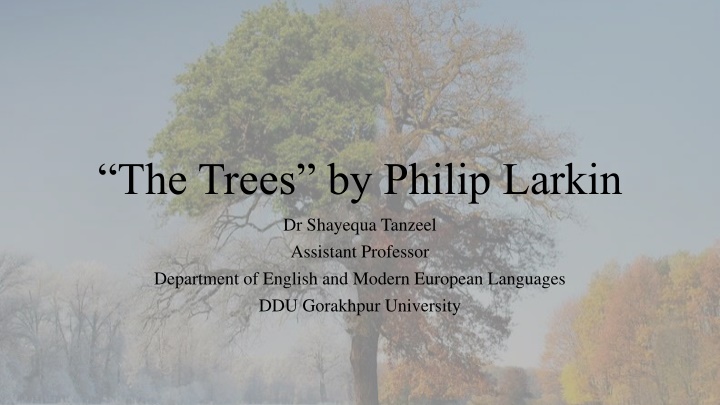
Analysis of Philip Larkin's Poem 'The Trees'
Explore an in-depth analysis of Philip Larkin's poem "The Trees" which delves into the comparison of tree cycles to human experiences, reflecting on life, aging, and renewal. Discover the metaphors used and the philosophical insights within this classic poem.
Download Presentation

Please find below an Image/Link to download the presentation.
The content on the website is provided AS IS for your information and personal use only. It may not be sold, licensed, or shared on other websites without obtaining consent from the author. If you encounter any issues during the download, it is possible that the publisher has removed the file from their server.
You are allowed to download the files provided on this website for personal or commercial use, subject to the condition that they are used lawfully. All files are the property of their respective owners.
The content on the website is provided AS IS for your information and personal use only. It may not be sold, licensed, or shared on other websites without obtaining consent from the author.
E N D
Presentation Transcript
The Trees by Philip Larkin Dr Shayequa Tanzeel Assistant Professor Department of English and Modern European Languages DDU Gorakhpur University
Philip Larkin (1922-1985) He graduated Oxford University in 1943 in English Language and Literature. Larkin was an English poet, librarian and novelist. He won several awards in his lifetime. He was offered the position of Poet Laureate in 1984 which he declined. Larkin s poems are known for their flexible structure and verse forms. His poetry engages directly with commonplace experiences and objects in an ordinary, colloquial and clear language. Poetic collections include: The North Ship (1945) The Less Deceived (1955) The Whitsun Weddings (1964) High Windows (1974) Whivfff
Introduction to the Poem The Trees is a short poem by Philip Larkin (1922-1985) that compares the cycles of a tree to human experiences. The poem was written by Larkin in 1967 and published in his poetry collection High Windows (1974). The poem draws parallels between the seasonal changes in a tree to human life and suffering. The poem draws a connection between the seasonal activity of trees to the philosophy of emotional closure and opening of a new chapter.
Analysis The poem is neatly divided into three stanzas. Each stanza is devoted to a particular thought. The poem features a swift and effortless shift in thought from one stanza to another. Larking project human-attributes onto trees and its parts. The poem employs the metaphor of trees to suggest that aging and dying are essential features of life. The experiences of life are written down in our characters. However, one needs to let go of the past sufferings and begin over to live satisfied lives.
Stanza I Larkin begins the poem on a pleasant note describing the spring season when seemingly new leaves and buds appear on the trees. The poet is hopeful of a renewed life but this celebratory note is undercut by the fourth line of the stanza wherein the speaker remarks that the trees greenness signify some kind of grief, as if they are mourning for something. This synthesis of springtime joy with grief is typical of Larkin s outlook.
Stanza II The second stanza continues with a gloomy tone initiated in the fourth line of the first stanza. The speaker wonders it the trees are immortal whereas we are doomed to age and die. The speaker then clarifies that just like us trees do grow old and die too. Their age is stamped in the rings of grain in their trunks. Spring season is an annual trick for the trees to appear new.
Stanza III In the third and final stanza, Larkin suggests that despite the fact that the trees bear their share of suffering and death, they stand strong as unresting castles . Every spring season, the trees exhibit a relentless effort to grow back in their fullgrown thickness . To the speaker, the trees suggest that the past is dead and obsolete and we need to begin afresh with full vigour.
Language and Structure The Trees is typical of Larkin s poetic style. The language is simple, colloquial and lucid. Yet, Larkin achieves the seriousness of tone necessary for such a philosophical perspective on life. The poem is divided into three stanzas of four lines each rhyming abba cddc effe. Lines are written in iambic tetrameter.
Figures of Speech Personification Metaphor Simile Alliteration Rhetorical question
